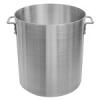This is clearly your predecessor's way of getting round the problems of replacing plastic guards etc. It can be difficult to find a replacement part, the manufacturer could have gone out business, stopped making the model of equipment that you have. Bespoke replacement guards are sometimes very expensive and your predecessor may have come under pressure to find a way out of the problem.
It is a fact that some plastic items will crack over time and use but often a crack in itself is not a contamination hazard. When you get two cracks joining together that is when a piece is likely to fall out and contaminate your product. This is often seen around bolt holes in the plastic.
I have seen a number of ways round the problem: -cutting a V as you have seen ( I have seen this method not lasting long and the cracks get worse.) , drilling a hole at the end of the crack and the simplest method of using a marker pen to put a line at the end of the crack with a date to demonstrate that the crack is not getting worse.
I also favour a different approach. If it is not necessary to see through the guard or other item, don't use plastic, use metal or if you do need some element of visibility, use a metal mesh design. All stainless of course but it it is always horses for courses.














